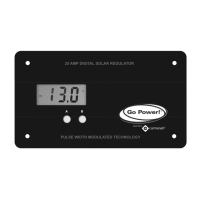Owner’s Manual | GP-PWM-25 Regulator
15
© 2009 Carmanah Technologies Corporation
Last revised: July 2009
10.0 Glossary
Ampere: A unit of electrical current. Designates the number of electrons flowing per second through a conductive
material.
Array: One or more photovoltaic (PV) modules electrically connected to produce a single electrical output.
Battery: Two or more electrochemical cells connected to provide energy storage.
May be used to designate one cell. PV system batteries may be “sealed” or “wet acid”.
Charge Controller: The PV system component that controls the battery’s state of charge. It may also provide other
system control functions. Also referred to as a regulator.
Charge Rate: The current applied to a battery to restore its energy capacity. The battery manufacturer will usually have a
recommended charge rate for their product. The rate is typically 10 –20 percent of the amp hour capacity at the 20-hour
rate.
Current: DC or Direct Current is the type of electron flow provided by a battery or solar cell, which flows in one direction.
The unit for current is ampere or amp for short and designated by the letter A.
Deep Cycle Battery: Batteries that are designed to discharge as much as 80% of their capacity as opposed to engine-
starting or “shallow cycle” batteries which are designed for heavy cranking but will not stand up to repeated deep
discharges.
Equalization: The process that equalizes the specific gravity of all the cells in a battery by means of a controlled
overcharge that breaks down sulfation on the battery plates. Most inverter/chargers and some charge controllers are
equipped with this feature.
Maximum Power: Also referred to as peak power. The point of a solar array, panel or module output where the product
of “Imp” and “Vmp” (“Pmax”, measured in watts) is maximized. The points used to calculate Pmax are Imp (current @ max
power) and Vmp (voltage @ max power).
Solar Module: A number of solar cells electrically connected, and protected from the environment usually by an
aluminum frame covered with a pane of glass. A module is self-contained and not sub dividable, therefore providing a
single electrical output.
Open-Circuit Voltage (Voc): Refers to a photovoltaic device’s voltage potential when it is disconnected from the rest of
the PV system.
Parallel Connection: Electrical connection where the positive terminals of a number of devices are connected together,
as are their negative terminals. The output voltage is usually limited to the device with the lowest voltage, and the total
current is the sum of the current of all the devices.
Photovoltaic (PV): Capable of producing a voltage when exposed to radiant energy, especially light.
Sealed Batteries: Electrolyte will not spill out and gassing is kept to a minimum. A sealed battery is maintenance free
and may be installed in several orientations. GEL and AGM are two common types of sealed batteries.
Series Connection: Electrical connection where the positive terminal of one device is attached to the negative terminal
of the next in a series string; in this connection, the string voltage is the sum of the device voltages and the string current
is limited to the current of the least productive device in the string.
Short-Circuit Current (Isc): Refers to a photovoltaic device’s current output when the positive terminal is directly
connected to the negative terminal.
State of Charge (SOC): The percentage of energy in a battery referenced to its nominal full capacity.
Sulfation: The formation of lead sulfate crystals on the plates of a lead-acid battery. Normally used to refer to large
sulfate crystals, rather than small crystals formed in normal battery operation. The plates of a battery will sulfate if left in a
partially charged state, causing reduced battery capacity and shortening the life of the battery. If caught in time,
equalization will remove the buildup of sulfation.
Voltage: The electrical potential between two points. Voltage is analogous to water pressure in that it pushes the
electrons or current through a conductor. The unit for voltage is volt and designated by the letter V.
Wet Acid or Flooded Batteries: The most common type of PV battery. Battery caps may be removed to expose the
electrolyte liquid inside the battery. Need proper ventilation due to gassing and may need to be topped up with distilled
water at regular intervals.

